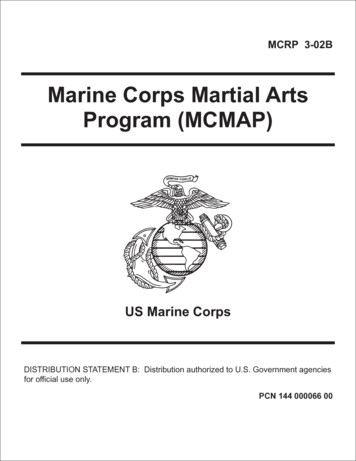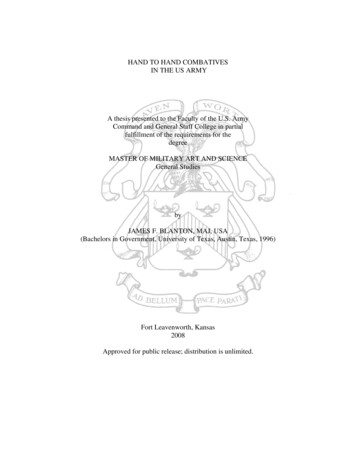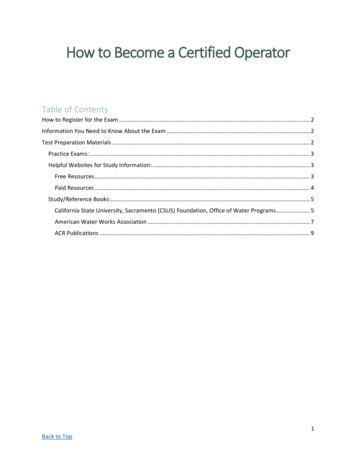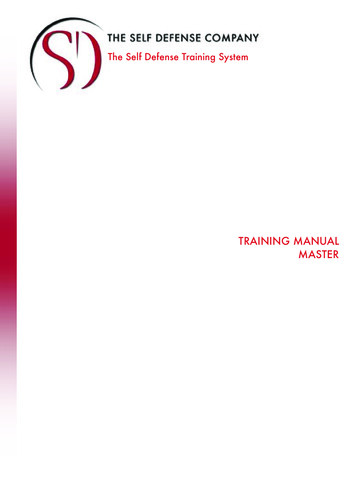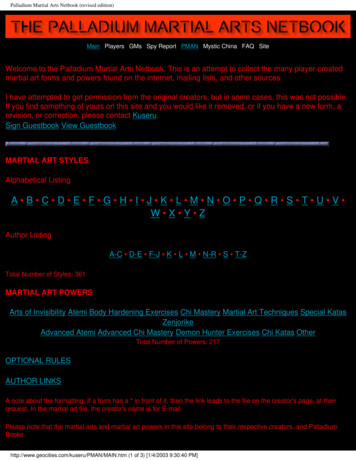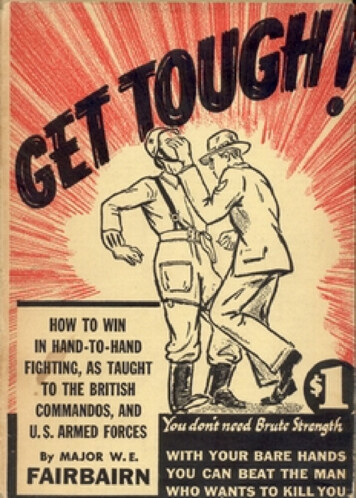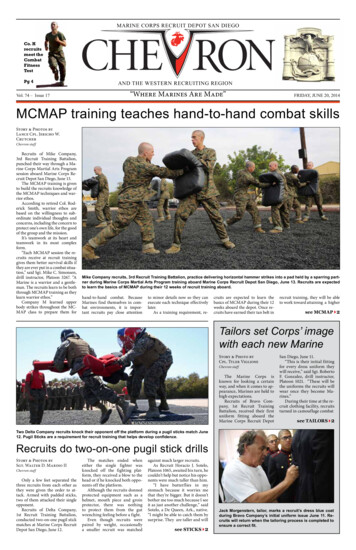
Transcription
MARINE CORPS RECRUIT DEPOT SAN DIEGOCo. Hrecruitsmeet theCombatFitnessTestPg 4Vol. 74 – Issue 17AND THE WESTERN RECRUITING REGION“Where Marines Are Made”FRIDAY, JUNE 20, 2014MCMAP training teaches hand-to-hand combat skillsStory & Photos byLance Cpl. Jericho W.CrutcherChevron staffRecruits of Mike Company,3rd Recruit Training Battalion,punched their way through a Marine Corps Martial Arts Programsession aboard Marine Corps Recruit Depot San Diego, June 13.The MCMAP training is givento build the recruits knowledge ofthe MCMAP techniques and warrior ethos.According to retired Col. Roderick Smith, warrior ethos arebased on the willingness to subordinate individual thoughts andconcerns, including the concern toprotect one’s own life, for the goodof the group and the mission.It’s teamwork at its heart andteamwork in its most complexform.“Each MCMAP session the recruits receive at recruit traininggives them better survival skills ifthey are ever put in a combat situation,” said Sgt. Mike C. Simonsen,drill instructor, Platoon 3267. “AMarine is a warrior and a gentleman. The recruits learn to be boththrough MCMAP training as theylearn warrior ethos.”Company M learned upperbody strikes throughout the MCMAP class to prepare them forMike Company recruits, 3rd Recruit Training Battalion, practice delivering horizontal hammer strikes into a pad held by a sparring partner during Marine Corps Martial Arts Program training aboard Marine Corps Recruit Depot San Diego, June 13. Recruits are expectedto learn the basics of MCMAP during their 12 weeks of recruit training aboard.hand-to-hand combat. BecauseMarines find themselves in combat environments, it is important recruits pay close attentionto minor details now so they canexecute each technique effectivelylater.As a training requirement, re-cruits are expected to learn thebasics of MCMAP during their 12weeks aboard the depot. Once recruits have earned their tan belt inrecruit training, they will be ableto work toward attaining a highersee MCMAP42Tailors set Corps’ imagewith each new MarineStory & Photo byCpl. Tyler ViglioneChevron staffThe Marine Corps isknown for looking a certainway, and when it comes to appearance, Marines are held tohigh expectations.Recruits of Bravo Company, 1st Recruit TrainingBattalion, received their firstuniform fitting aboard theMarine Corps Recruit DepotSan Diego, June 11.“This is their initial fittingfor every dress uniform theywill receive,” said Sgt. RobertoF. Gonzalez, drill instructor,Platoon 1021. “These will bethe uniforms the recruits willwear once they become Marines.”During their time at the recruit clothing facility, recruitsturned in camouflage combatsee TAILORS42Two Delta Company recruits knock their opponent off the platform during a pugil sticks match June12. Pugil Sticks are a requirement for recruit training that helps develop confidence.Recruits do two-on-one pugil stick drillsStory & Photos bySgt. Walter D. Marino IIChevron staffOnly a few feet separated thethree recruits from each other asthey were given the order to attack. Armed with padded sticks,two of them attacked their singleopponent.Recruits of Delta Company,1st Recruit Training Battalion,conducted two-on-one pugil stickmatches at Marine Corps RecruitDepot San Diego, June 12.The matches ended wheneither the single fighter wasknocked off the fighting platform, they received a blow to thehead or if he knocked both opponents off the platform.Although the recruits donnedprotected equipment such as ahelmet, mouth piece and groinprotector, there was nothingto protect them from the gutwrenching feeling before a fight.Even though recruits werepaired by weight, occasionallya smaller recruit was matchedagainst much larger recruits.As Recruit Horacio J. Sotelo,Platoon 1065, awaited his turn, hecouldn’t help but notice his opponents were much taller than him.“I have butterflies in mystomach because it worries methat they’re bigger. But it doesn’tbother me too much because I seeit as just another challenge,” saidSotelo, a De Queen, Ark., native.“I might be able to catch them bysurprise. They are taller and willsee STicks42Jack Morgenstern, tailor, marks a recruit’s dress blue coatduring Bravo Company’s initial uniform issue June 11. Recruits will return when the tailoring process is completed toensure a correct fit.
2CHEVRON NEWS JUNE 20, 2014Car Show on the BayThe depot will sponsor a Car Showon the Bay June 22, from 11 a.m. until3 p.m., at the new waterfront locationon the Bay View Marina lawn.There will be live entertainment,door prizes, awards, food and activities.For more information call(619) 725-6484. Or call (619) 5245732/5728/5301, or contact Perlita Rodriguez via e-mail at perlita.rodriguez@usmc.mil, or visit www.mccsmcrd.com.Freedom RunThe depot will sponsor a 5K Freedom Run/1 Mile Walk on June 27,starting from the Bay View Marina at1 p.m.Depot Summer ConcertMike Company recruits execute the horizontal hammer strike during a Marine Corps Martial Arts Program session. Company Mlearned upper body strikes throughout the MCMAP class, which prepares them for hand-to-hand combat.MCMAP31belt with follow-on training in the FleetMarine Force.“We teach the basics here so they canbuild off of what they will already knowin the fleet,” said Simonsen, a Bozeman,Mont., native. “This is their second session of MCMAP training, and they willreceive a lot more training toward earning their tan belts.”Executing numerous repetitions ofeach move not only worked on theircombat conditioning, but built musclememory to ensure recruits can conducteach move proficiently.“In combat, Marines don’t alwayshave a lot of time to think about a situation so they have to be able to reactwithin seconds. That is where countlessrepetitions from practice comes in toplace,” said Recruit Zaine S. Wilcox, Platoon 3267. “The drill instructors makeus keep pushing through each repetitioneven though we are exhausted because ina real life situation, it’s a matter of life ordeath.”Before leaving the class, Sgt. JosephA. Kimmel, Marine Corps Martial ArtsProgram Instructor, made sure the recruits felt comfortable with the MCMAPtechniques and knew how it could effectively help them in a needed situation.“If the situation occurred, I want tofeel confident utilizing the MCMAPtechniques to save my life or save thelife of a fellow Marine,” said Wilcox, aCaldwell, Ind., native.Company M is currently on week twoand has several weeks and MCMAP sessions to go before earning their tan beltsand earning the title Marine.sticks31probably attack high, I’ll attack low.”Every time a trio of recruits attackedeach other the clash could be heard likehelmets at a football game. Each matchnot only produced intensity and force, butit also developed a valuable confidence ineach recruit.Sgt. John D. Weltzin, drill instructor,Platoon 1065, explained he believes pugilsticks are a confidence builder for recruitsbecause he remembers the event instillingconfidence in himself as a recruit.“When I did pugil sticks, I was a realtimid person. But, I gained confidencefrom it, and the next time we did it Iwas ready,” said Weltzin. “I won my nextfight.”Weltzin explained one bout of pugilsticks doesn’t cure being timid or fix alack of confidence, but in conjunctionwith the rest of recruit training, it helpsbuild a stronger person.“Some recruits are born fighters, theysee an opponent and are ready,” said Weltzin. “Some recruits are timid, we (drill instructors) focus a little more on the timidones and try and get them there, too.”Sotelo agreed with Weltzin and saidhe’s glad recruits participate in pugilsticks matches.“It takes away a little fear and instillsa little confidence, but I wouldn’t recommend it for the elderly,” said Sotelo witha grin.Marine Band San Diego willperform at the annual Depot SummerConcert June 28 at 4 p.m.The concert will be held at Pendleton Hall on the Commanding General’s Honors Lawn.Bring lawn chairs or blankets andspend a memorable afternoon filledwith great music. The concert willfeature selections from the band’svaried repertoire of traditional classics,patriotic marches and newer favorites.The concert is free and open to thepublic.A trip to VegasThe Single Marine Program issponsoring a trip to Las Vegas July2 - 5.Participants will travel in two12-passenger vans and stay at theQuad Hotel across the strip fromCaesar’s Palace. Cost is 50 for traveland lodging. Each person will coverfood and entertainment expenses outof pocket.There are only 20 places availableand participants must be 21 or older.Reservations are required on a firstcome, first-served basis.For more information or to sign up,contact Kelley Sitar at (619) 524-5655,or via e-mail at sitark@usmc-mccs.org.MCRD chapel closureThe chapel is closed for renovationsuntil July 25.During the project Sunday Lutheran services will join the Protestantservice in the Base Theater auditoriumat 8:30 a.m. Catholic Mass will be heldin the Bride Room next to the Chapelon Tuesdays, Wednesdays and Thursdays at 11:45 a.m.For information contact AnnaTorres, administrative support assistant for Religious Ministries at (619)524-8820.Nate Smith ScholarshipapplicationsRecruit Horacio J. Sotelo, Platoon 1065, dons his helmet in preparation for a pugilsticks match.tAILORS31utility uniforms to have name tapes sewn on, something they arenot allowed to have until week eight. Each recruit also received aset of dress uniforms that were tailored to fit them.Training day 43 was not only important for the recruits because they received their uniforms, but also because they reachedanother marker in their recruit training experience.“This is another stepping stone in recruit training,” said ChaseW. Swann, Plt. 1023. “This is the next step in our pursuit to becoming Marines.”According to Swann, being able to put on the uniform and getit fit gave him a confidence and psychological boost to push onand complete the rest of recruit training.“Putting on the uniform makes me proud that I have accomplished everything to make it to this point in training,” saidSwann, a native of Scroggins, Texas. “Not everybody gets a chanceto put these uniforms on.”The Marine Corps uniform dates back to the birthdate of theMarine Corps and distinguishes Marines from the other branchesof service. Some details in the uniforms reflect the proud legacyof Marines who have worn them for the more than two centuries.“We all wear the uniforms while we are in the Marine Corps,”said Gonzalez, a native of Detroit. “What makes a difference ishow they look. Since these recruits are receiving their initial issue, we want to make sure they are as squared away as possible.”Although recruits were fitted for their dress uniforms, they arenot allowed to wear them until family day and graduation, afterthey have earned the title “Marine.“We still have events to push through before we become Marines,” said Swann. “We are going to take this and let it motivateus to do the best as we can until the end.”The MCRD Museum Foundationis taking applications for the ColonelNate Smith Memorial Scholarshipprogram through July 8.Three 1,000 scholarships will beawarded during July. Applicants mustbe enlisted Marines, sailors or theirdependents, and assigned to MCRD/WRR San Diego.Application forms and eligibilitydetails may be found at www.mcrdmhs.org. The forms are also availableat the Foundation’s office in Bldg. 26,at the MCRD Command Museum.For more information, contactLynn Stuart at (619) 524-4426.Send briefs to:rdsd pao@usmc.mil. The Chevronstaff reserves the right to publish onlythose briefs that comply with Department of Defense regulations and thestandards of the U.S. Government.
CHEVRON AROUND THE CORPS JUNE 20, 20143Lance Cpl. Kyle McNicholas, an infantryman with Black Sea Rotational Force 14 from 3rd Battalion, 8th Marine Regiment, fires an AT-4 light anti-armor weapon during exercise Agile Spirit aboard Vaziani Training Area, Georgia, June 11, 2014. Agile Spirit 14 is an annually-scheduled multilateral engagement hosted by Georgiathat began in 2011 in order to strengthen the two countries by conducting brigade and battalion-level training engagements, to include small-unit interaction between the Marines and Georgians that demonstrates their commitments toward collective, global security.Marines and sailors, Georgians conclude live-fire portion of Agile SpiritStory & Photos byLance Cpl. Scott WhitingBlack Sea Rotational Force Public AffairsOfficeVAZIANI TRAININGAREA, Georgia – ExerciseAgile Spirit 14 started with a“bang” as Marines and sailorswith Black Sea RotationalForce 14, from 3rd Battalion,8th Marine Regiment, firedon various weapon rangeswith soldiers of the GeorgianArmed Forces in the VazianiTraining Area, Georgia, June10-11, 2014.Agile Spirit 14 is an annually-scheduled bilateralengagement hosted by Georgiathat began in 2011 in order tostrengthen interoperabilitybetween the two countriesby conducting brigade andbattalion-level training engagements, to include smallunit interaction between theMarines and Georgians thatdemonstrates their commitments toward collective,global security.“The ranges were prettywell-paced,” said Lance Cpl.Patrick Phelan, a forwardobserver with 81mm Platoon,Weapons Company. “It gavesome Marines the opportunity to fire a lot of weaponsystems they don’t normallyfire. There were known rangeshoots, which is always goodpractice for us. The machinegun range builds familiaritywith those of us who don’ttypically get time to fire(heavy machine guns).”The Marines and Georgiansfired the M2 .50-caliber heavymachine gun, the M249 lightmachine gun, the M240Bmedium machine gun, theAT-4 anti-tank weapon systemand the light armor weapontrainers, along with theirstandard service rif les, the M4and M16, and M27 InfantryAutomatic Rif le.“These are weapons organicto an infantry unit,” Phelansaid. “These are all thingswe should be familiar with.We won’t always be using ourservice rif les; we may have topick up a machine gun andknow how to use it.”These live-fire weaponranges set the tone for the restof the exercise.“This really joins the Marines and Georgian soldiers atthe hips,” said Capt. ThomasPerna, the platoon commander for the CombinedAnti-Armor Team, WeaponsCompany. “The more exposure we have to each other’stechniques, we can integrateand operate more effectivelyand focus on the nuts andbolts of making a cohesiveunit together.”Next on tap forthe Marines and Georgiansis lane training, where they’lltrain together in reacting todifferent scenarios, to includeimprovised explosive devices,cordoning and searching andsecurity patrolling.“I think (Agile Spirit) isa great opportunity to buildthose relationships,” Pernasaid. “We’re teaching themthings, and they’re teachingus a lot as well. They do somethings differently, which isgood because it exposes us toa different mindset. I’m excited to see what happens duringthe rest of the exercise.”Black Sea Rotational Force14 is a rotational contingentof Marines and sailors positioned to build robust militaryrelations with partner nations,increase regional stabilityand enable interoperabilitywhile providing the capability for contingency response,as directed by U.S. EuropeanCommand, in the Black Sea,Balkan and Caucasus regionsof Eastern Europe.PUBLIC AFFAIRS DIRECTORMaj. Neil A. RuggieroE S TA BL I S H E D 1942COMMANDING GENERALBrig. Gen. James W. BiermanSERGEANT MAJORSgt. Maj. James K. Porterfield.Lance Cpl. Aaron Keene, Black Sea Rotational Force, 3rd Battalion, 8th Marine Regiment, fires anM-249 light machine gun during a course of fire that also included the M-4 service rifle and theM-2 .50 caliber heavy machine gun during exercise Agile Spirit 14.Gunnery Sgt. Matthew J. Richey, Black Sea Rotational Force 14, 3rd Battalion, 8th Marine Regiment, explains the components and functionality of the AT-4 light anti-armor weapon to Georgiansoldiers during a live-fire exercise. This fourth iteration of the Agile Spirit exercise will run untilJune 21.PRESS CHIEFSgt. Walter D. Marino IIPUBLIC AFFAIRS DEPUTYJanice M. HagarCOMBAT CORRESPONDENTSCpl . Tyler ViglioneL ance Cpl . Jericho CrutcherPUBLIC AFFAIRS CHIEFGunnery Sgt. Jennifer M. AntoineEDITORRoger Edwardschevron/public affairs office1600 henderson ave. #120san diego, ca. 92140(619) 524-8722WWW.MCRDSD.MARINES.MILThe Chevron is published on the internet at the above address by MarineCorps Recruit Depot San Diego personnel. Opinions and views expressedherein are not necessarily those of the Marine Corps or the Department ofDefense. The Chevron is promulgated for informational purposes only andin now way should be considered directive in nature. All photos are officialUSMC property unless otherwise indicated.
CHEVRON FEATURE JUNE 20, 201445Recruits complete first CFTStory & Photos bySgt. Walter D. Marino IIChevron staffAlthough no form of training can completely replicate thestrains of combat, there are someexercises that can come close.Recruits of Hotel Company,2nd Recruit Training Battalion,finished their first combat fitnesstest at Marine Corps RecruitDepot San Diego, June 11. TheCombat Fitness Test includes a880-yard run, ammunition-canlifts and a maneuver under fire.The CFT is a 300-point physical fitness test with an emphasison functional fitness related tooperational demands such ascombat.The 880-yard run kicks off thebeginning of the CFT, the ammunition-can lifts are the secondexercise and the maneuver-underfire concludes the CFT. All stagesof the CFT are conducted in bootsand camouflage utilities.Some of the combat-relatedexercises are conducted in themaneuver-under-fire portion ofthe event. In this section, recruitsare required to perform a fireman’s carry and throw a dummygrenade to a designated area.“I think the CFT is beneficialbecause things like the fireman’scarry are techniques you woulduse in combat, and that gives us adifferent outlook on what a combat experience could be like,” saidRecruit Tristan B. Butler, Platoon2163.Each section of the CFT wasgraded, but because it was therecruit’s introduction to the exercise, it was not recorded.Half way through the CFT,some recruits showed signs offatigue and pain. Some recruitssaid they were trying hard despitebeing sick and others spoke of theminor injuries they were fightingthrough.“My calf is killing me, and I’mpretty sure I pulled it,” said Butler,Platoon, a Show Low, Ariz., native. “But I just visualize my wifeand son waiting for me at the endof the exercise, and it gets me toperform better.”Recruit Hunter D. Buley,Platoon 2162, said his goal for theexercise was to get a perfect score.Each event is worth 100 points fora total of 300.“To get a perfect score wouldgive me a sense of pride becauseit takes a lot to accomplish that,”said Buley. “If you push yourself,it’s very difficult and even if youdon’t, the CFT is still difficult.”Although neither Buley norButler received a perfect score,they both explained it’s not a failure but rather a new goal to worktoward.“I’m going to continue workout and get stronger,” said Buley.“Every CFT after this my scorewill get better.”Hotel Company recruits, 2nd Recruit Training Battalion, begin their 880-yard run during the Combat Fitness Test at Marine Corps Recruit Depot San Diego, June 11. The recruits were told the requirements and techniques for each section of the CFTbefore they started the test.Hotel Company recruit Josue Torres, Platoon 2167, conducts ammunition-can lifts during the CombatFitness Test. Torres is a Santa Maria, Calif., native.Hotel Company recruit Hunter D. Buley, Platoon 2162, waits for the command to start the maneuver-under-fire portion of the Combat Fitness Test. The maneuver-under-fire exercise is the last exercise conducted in the CFT. Buley is a Harrah, Okla., native.Hotel Company recruit Tristan B. Butler, Platoon 2163, conductsa fireman’s carry during the Combat Fitness Test. Partners for theevent must weigh within 10 pounds of each other. Butler comes fromShow Low, Ariz.
CHEVRON FEATURE JUNE 20, 20146Haiti native becomes a U.S. citizen and U.S. MarineStory & Photo byLance Cpl. Jericho W.CrutcherChevron staffFor centuries the U.S. hasbeen a melting pot for peopleof all races, colors and religionswho are searching for betteropportunities for themselvesand their families. For one newMarine, America offered muchmore than the hope of opportunity. The Marine Corps gavehim the brotherhood for whichhe’d been searching, and thecountry offered him citizenship.Pvt. Jean G. Volcy, Platoon3243, Lima Company, 3rd Recruit Training Battalion, participated in a ceremony yesterday,and was naturalized as a newcitizen of the United States. Today he and his Lima Companybrothers graduate from recruittraining as U. S. Marines.Volcy recruit trainningwas born and raised in Haiti.While he enjoyed living there,Haiti suffers from deforestation,which causes frequent, massiveflooding, leaving the countrylacking in natural resources.“It’s a tropical environment,and I like that, but resources arevery limited there,” said Volcy.“Water would only come to us afew days out of the week, so wewould store as much as we couldin jugs or anything else thatwould hold water.”Volcy learned great disciplineat an early age. He believes thatis something that developedwhen he started catholic school.“I’ve always been drawn tothings that take great disciplineto get through, and I knew byattending a catholic school Iwould have to stay very disciplined due to the strictness,”said the native of Port-AuPrince. “I think the disciplinethe Marine Corps displays isultimately what sealed my decision to join.”His discipline was reinforcedby his parents, who he said arehard workers, who always madesure he and his siblings hadeverything they needed.“My mother has always beendisciplined, even when it comesto her job. She has worked at abank for 30 years,” said 25-yearold Volcy. “My father is anaccountant and received his education in New York City, whilemy mother attended school inHaiti.”By the time Volcy turned 15,the political environment ofHaiti was a hotbed of corruptionand safety was a major concernfor many families. His parentsmade the difficult decision tohave him and his younger sistermove to America to live with hisolder brother, a member of theUnited States Air Force.“Haiti became politicallyunstable and kidnappings werestarting to occur very often,”said Volcy. “My mother fearedsomething would happen tome and my sister if we stayedin Haiti, which is why she sentus to live with my brother inAmerica.”The children began school inFayetteville, N.C., where Volcyparticipated in sports such assoccer and track. He was interested in anything that took agreat amount of discipline.The three siblings lived inNorth Carolina for a year, andthen moved to San Antonio,Texas when his brother becamean Air Force instructor at Lackland Air Force Base.“My brother took me to workwith him a couple of times whenhe became an instructor, and itwas cool to see how they trainedtheir recruits to become airmen,” said Volcy.The high school senior knewhe wanted to join the military,but did not take the step rightaway, choosing to further hiseducation instead.“At first I wanted to go to college. I couldn’t get the financialaid I needed to help pay for it,so I just got a job and went towork,” said Volcy. “After sixyears, I decided I was tired ofdoing the same thing. I felt likeit was my calling to join theLt. Gen. Terry G.RoblingParade Reviewing OfficerLt. Gen. Terry G. Robling is thecommander, U. S. Marine Corps Forces,Pacific.Robling entered the Marine Corpsin 1976 after graduating from CentralWashington University with a degreein business administration. Followinggraduation from the Basic School inApril 1977, he began flight training andearned his wings in November 1978.Upon completion of F-4 Phantomtransition training at Marine CorpsAir Station Yuma, Ariz., he reported toMCAS Kaneohe Bay, Hawaii, and joinedthe “Lancers” of Marine Fighter AttackSquadron (VMFA) 212. As a “Lancer,”Robling attended the United StatesNavy Strike Fighter Tactics Instructorprogram (Top Gun), and participated intwo Western Pacific (WestPac) deployments to Iwakuni, Japan. During histhree-year tour with VMFA-212, he heldvarious billets including maintenancecontrol officer, assistant maintenanceofficer, and aircraft maintenance officer.In June 1983, Robling reported toAmphibious Warfare School at Quantico, Va., and upon graduation returnedBefore Pvt. Jean G. Volcy, Platoon 3243, Lima Company, 3rd Recruit Training Battalion, receives hisnaturalization papers following a naturalization ceremony aboard Marine Corps Recruit Depot SanDiego, Calif., June 19. Volcy was born and raised in Haiti before coming to America. For centuries theU.S. has been a melting pot for people of all races, colors and religions searching for opportunitiesfor themselves and their families. For this new Marine, America offered much more than the hope ofopportunity.Marine Corps, so I talked tothe recruiter, and he told meabout the amount of discipline itwould take and the brotherhoodthe Marine Corps offers.”Volcy explained he is a manwho is committed to his familyand the Marine Corps reinforcesthat trait.“My recruiter told me if I waslooking for brotherhood anddiscipline, then I was joiningthe right branch of military,”said Volcy. “Honor, courage andcommitment are things I reallycherish close to my heart.”to MCAS Kaneohe Bay for duty withVMFA-235. As a “Death Angel,” he heldassignments as the assistant operationsofficer and aircraft maintenance officer,completed two more WestPac deployments and attended the Weapons andTactics Instructor Course.In June 1987, Robling reported toHeadquarters Marine Corps where heserved as aviation programs officer forthe Deputy Chief of Staff for Aviation. During this tour, he was one of24 officers selected for training on theF/A-18D Hornet on the first “Delta”transition board. In August 1989, he reported to Marine Fighter Attack Training Squadron (VMFAT) 101 at MCASEl Toro for F/A-18 Hornet transitiontraining. When he completed training,Robling he remained with the “Sharpshooters” as the aircraft maintenanceofficer as well as a pilot and weaponsystems officer instructor.In December 1990, Robling reportedto the newly redesignated MarineAll- Weather Fighter Attack Squadron(VMFA - AW) 242 and assumed theduties as executive officer. In June 1992,he was reassigned as the commandingoOfficer of the unit and completed another WestPac deployment to Iwakuni,Japan. As the commanding officer, Robling was selected as the Marine CorpsNaval Flight Officer of the Year in 1993.In August 1994, Robling reportedAfter going through recruittraining, Volcy realized hefound the brotherhood he hadbeen looking for.“We’ve all experienced a lotin the few months we have beenat recruit training,” said Volcy.“The thing I love the most is thefact that I can look to the Marines on my left and right andknow they will always be thereno matter what. We look out foreach other.”Now that Volcy has graduatedrecruit training, he will attendfour weeks of Marine Combatto the National War College where heearned a Master of Science Degree inNational Security Strategy. Followinggraduation, he reported to the chairman, Joint Chiefs of Staff, Washington,D.C., for duty as the current operationsofficer, Central Command Division ofthe Joint Operations Department.In August 1998, Robling was selectedfor a foreign affairs fellowship, andattended Johns Hopkins University atthe School of Advanced InternationalStudies in Washington, D.C. Uponcompletion of the fellowship, he wasreassigned to the Director of Expeditionary Warfare, Office of the Chief ofNaval Operations, as the resource andrequirements officer for unmannedaerial vehicles.In January 2000, Robling assumedcommand of Marine Aircraft Group 11.In August 2001, he assumed the dutiesof chief of staff for the 3rd Marine Aircraft Wing at MCAS Miramar, Calif.In June 2002, Robling assumed theduties of assistant wing commander forthe 3rd Marine Aircraft Wing.In January 2003, Robling deployedfor Operation Iraqi Freedom. He wasdesignated commanding general, 3rdMAW Forward in June 2003, and returned to Miramar in September 2003.In July 2004, he assumed duty as chiefof staff, Striking and Support ForcesNATO, in Naples, Italy.Training at Marine Corps BaseCamp Pendleton, Calif., forfurther training. Once that iscompleted, he will continue tofollow-on training to learn hismarine occupational specialty asa motor transportation operator.Volcy has his future goals sethigh. Upon completion of hisfour years as an enlisted Marine,he would like to attend the U.S.Naval Academy in Annapolis,Md., to become an officer andMarine Corps leader. He hasaspirations of making the Corpsa career.In July 2006, Robling was assigned toserve as the director, Strategy and PlansDivision in Plans, Policy and Operations, Headquarters, U.S. Marine Corps.In July 2007, Robling assumed command of the 3rd Marine Aircraft Wing,where he served until August of 2009.In September 2009, he assumed command of the III Marine ExpeditionaryForce and Marine Corps Bases Japanuntil he transfered to Headquarters Marine Corps in January 2011, as DeputyCommandant for Aviation.Robling took command of MarineForces Pacific in August 2012.
CHEVRON GRADUATING COMPANY JUNE 20, 20147Platoon 2111Platoon 3245COMPANY HONOR MANPfc. G. A. CruzGriffith, Ind.Recruited bySgt. R. JimenezPlatoon 3243SERIES HONOR MANPfc. D. C. BakerPhoenixRecruited bySgt. J. C. ChavezHONORPLATOONCOMPANY LCommanding OfficerCapt. D. J. EckerlyCompany First SergeantGunnery Sgt. M. RamirezPlatoon 3241Platoon 3242PLATOON HONOR MAN PLATOON HONOR MANPfc. C. B. MoatesHoustonRecruited bySgt. W. A. RudisillPfc. A. M. HottingerCheyenne, Wyo.Recruited bySgt. S. SandordPlatoon 3246PLATOON HONOR MANPfc. K. R. ShackelfordWillowbrook, TexasRecruited byStaff Sgt. W. RudisillPlatoon 3247PLATOON HONOR MANPfc. S. H. BreslinFlint, Mich.Recruited bySgt. A. L. SullivanPlatoon 3243HIGH SHOOTER (347)Pfc. N. Alvarez-Ramire
Jun 20, 2014 · ner during Marine Corps Martial Arts Program training aboard Marine Corps Recruit Depot San Diego, June 13. Recruits are expected to learn the basics of MCMAP during their 12 weeks of recruit training aboard. MCMAP training teaches hand-to-hand combat skills hand-to-hand combat. Because Marin
